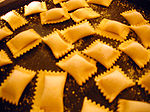
Agnolotti
Encyclopedia

Ravioli
Ravioli are a traditional type of Italian filled pasta. They are composed of a filling sealed between two layers of thin egg pasta dough and are served either in broth or with a pasta sauce. The word ravioli is reminiscent of the Italian verb riavvolgere , though the two words are not...
typical of the Piedmont
Piedmont
Piedmont is one of the 20 regions of Italy. It has an area of 25,402 square kilometres and a population of about 4.4 million. The capital of Piedmont is Turin. The main local language is Piedmontese. Occitan is also spoken by a minority in the Occitan Valleys situated in the Provinces of...
Region, made with small pieces of flattened pasta
Pasta
Pasta is a staple food of traditional Italian cuisine, now of worldwide renown. It takes the form of unleavened dough, made in Italy, mostly of durum wheat , water and sometimes eggs. Pasta comes in a variety of different shapes that serve for both decoration and to act as a carrier for the...
dough, folded over with a roast beef meat and vegetable stuffing. Agnolotti is the plural form of the Italian word agnolotto. The origin of the name may come from the name 'Angelot' from Montferrat
Montferrat
Montferrat is part of the region of Piedmont in Northern Italy. It comprises roughly the modern provinces of Alessandria and Asti. Montferrat is one of the most important wine districts of Italy...
, who is said to be the inventor of the recipe, or from the Latin word 'anellus', which refers to the ring-shaped material within the pasta, per 'The Word Origin Calendar 2009' compiled by Gregory McNamee and published by Accord Publishing.
Overview
Traditionally agnolotti are of a square shape, side of about 1 inch. However, they can also be of a rectangular smaller shape when they are called 'Agnolotti al Plin'. 'Plin' means a 'pinch' because you pinch with thumb and forefinger between each mound of filling to close and seal the little pasta packets. Agnolotti al Plin are almost always made by hand and are typical of LangheLanghe
The Langhe is a hilly area to the south and east of the river Tanaro in the province of Cuneo in Piedmont, northern Italy....
and Monferrato.
Agnolotti are prepared by immersion in boiling water. Typically, they are dressed in a beef broth and a little melted butter or in a fresh sage and melted butter sauce, as a complex sauce would detract from the flavours in the agnolotti pockets. In both cases topped with Parmigiano Reggiano cheese but no cheese resides in the agnolotti. The dish is associated with Piedmont
Piedmont
Piedmont is one of the 20 regions of Italy. It has an area of 25,402 square kilometres and a population of about 4.4 million. The capital of Piedmont is Turin. The main local language is Piedmontese. Occitan is also spoken by a minority in the Occitan Valleys situated in the Provinces of...
in Italy
Italy
Italy , officially the Italian Republic languages]] under the European Charter for Regional or Minority Languages. In each of these, Italy's official name is as follows:;;;;;;;;), is a unitary parliamentary republic in South-Central Europe. To the north it borders France, Switzerland, Austria and...
and is not to be confused with Parma's stuffed pasta pockets called 'Anolini'.
Similar recipes with different stuffing without meat (e.g., ricotta
Ricotta
Ricotta is an Italian dairy product made from sheep milk whey left over from the production of cheese. Although typically referred to as ricotta cheese, ricotta is not properly a cheese because it is not produced by coagulation of casein...
cheese and spinach) are not properly agnolotti but ravioli
Ravioli
Ravioli are a traditional type of Italian filled pasta. They are composed of a filling sealed between two layers of thin egg pasta dough and are served either in broth or with a pasta sauce. The word ravioli is reminiscent of the Italian verb riavvolgere , though the two words are not...
.

